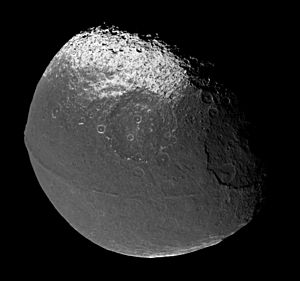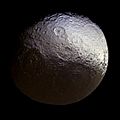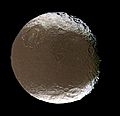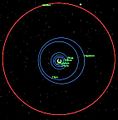Iapetus is a large moon of Saturn. It was discovered by Giovanni Domenico Cassini in 1671.
Iapetus is unusual: one side is very bright and the other side is very dark. This is because one half of the moon is covered in ice and the other side is coated in black, dusty carbon deposits. When Cassini observed the moon, he could only see the moon on one side of Saturn. He concluded that the moon is darker on side than the other, and it was confirmed by the Voyager 1 spacecraft. Iapetus also has an equatorial ridge discovered by the Cassini-Huygens spacecraft on 31 December 2004. Iapetus has a slow rotation rate, taking 79 Earth days for a rotation.
Images for kids
-
Size comparison of Earth, the Moon, and Iapetus (bottom left).
-
Natural-color image of Iapetus
-
View of Cassini Regio. Large craters visible include Falsaron (upper left), Turgis (above and right of center) and Ganelon (lower right)
-
The bright regions of Iapetus. Roncevaux Terra is at the top (north); Saragossa Terra with its prominent basin Engelier, Iapetus's second largest, is at the bottom.
-
Close-up of north polar region, with the large impact crater Falsaron near bottom
-
The color dichotomy of Iapetus. The redder color of the leading hemisphere can be seen in bright areas in a lower contrast image (left), and in dark areas in higher contrast images (right).
-
Close-up of 10-kilometer-high (6 mi) mountains within the equatorial ridge in Iapetus's dark region
-
Artist's impression of the Phoebe ring, which dwarfs Saturn's main rings
-
Closeup of the equatorial ridge
-
Computer simulation of the appearance of Saturn from Iapetus when it is at the "highest" point in its inclined orbit. Saturn's rings are clearly visible (from the other large moons they can only be seen edge-on).
-
Side view of Iapetus's orbit (red) compared to the other large moons, showing its unusually high inclination
-
Polar view of Iapetus's orbit (red) compared to the other large moons of Saturn
See also
 In Spanish: Jápeto (satélite) para niños
In Spanish: Jápeto (satélite) para niños

 In Spanish: Jápeto (satélite) para niños
In Spanish: Jápeto (satélite) para niños











